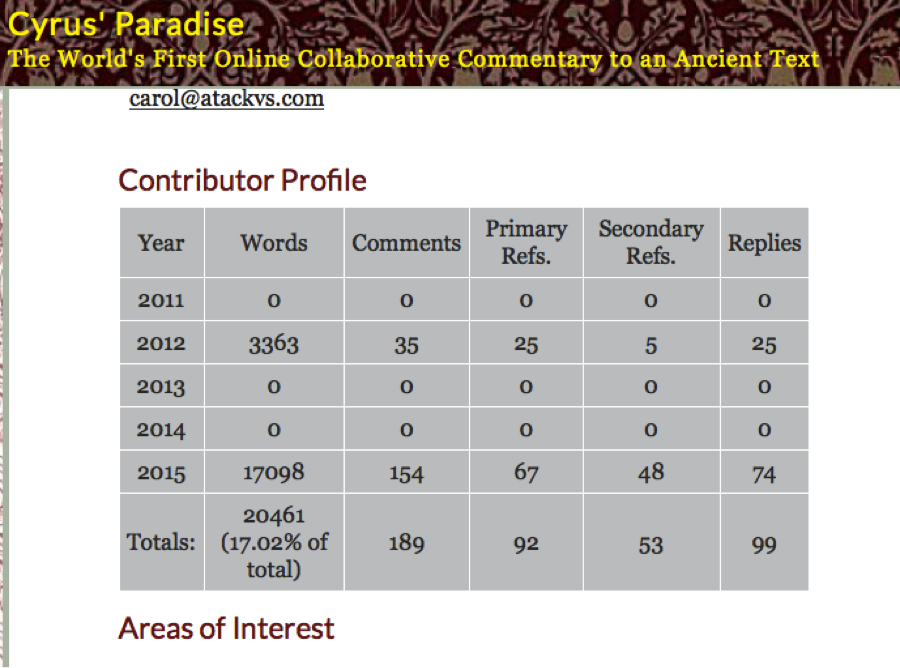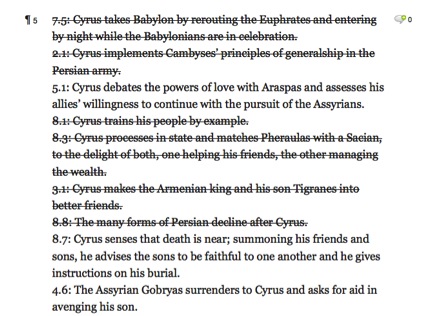“Let’s Play Ball!” Sabermetrics and Three Game Changers in Cyrus’ Paradise
¶ 1 Leave a comment on paragraph 1 0 Thanks to the great work of the Duke University Digital Humanities team, especially Will Shaw, Cyrus’ Paradise has now entered the realm of data analysis, along the lines of the sabermetrics approach familiar to fans of Major League Baseball. Below I outline three “game changers” that will more carefully quantify–and thus celebrate–all that contributors to the commentary are doing.
¶ 2 Leave a comment on paragraph 2 0 First of all, Cyrus’ Paradise now features buttons for commenters to tag their primary and secondary references. These references will then be displayed in red (primary references) and blue (secondary references).
¶ 3
Leave a comment on paragraph 3 0
Why is the work called the “Cyropaedia” or “Kouroupaideia” and how do we know?

¶ 4 Leave a comment on paragraph 4 0 These tags will be used in the future to develop statistical analyses of the commentary and to expand the ways in which the site can recognize and document, in quantitative ways, the scholarly contributions of commenters.
¶ 5 Leave a comment on paragraph 5 0 Secondly, those who are familiar with the game of baseball know that the RBI (runs batted in) is not necessarily the best predictor of a hitter’s future offensive productivity because this stat depends on a number of factors that are beyond a hitter’s control. The ability of other batters to get on base ahead of the hitter, their speed on the base-paths, and the coach’s strategy may affect a hitter’s RBI total–and these are all beyond the hitter’s control. Consequently, data analysts are continually looking for other stats that can better predict how productive a hitter is likely to be in the future. There is an entire field of research devoted to this question and many others in the game of baseball known as Sabermetrics.
¶ 6 Leave a comment on paragraph 6 0 In Cyrus’ Paradise we have begun to ask the question “what would a sabermetrics approach to online commenting look like?” In other words is there a way to measure a comment’s “goodness,” however we define it? What would the profile of a good commenter look like in quantitative terms? What would a good commentary itself look like? I hesitate to acknowledge that it may never be possible to completely quantify what a good comment or a good commenter looks like, but that does not mean we shouldn’t try. Certain quantitative measure can call attention to comments and commenters, at which point readers may make up their own minds.
¶ 7 Leave a comment on paragraph 7 0 Right now commenters in Cyrus’ Paradise have their very own “baseball cards,” which feature (year-by-year) word count, number of comments, primary references, secondary references, and number of replies to comments, as well as a word cloud of all comments and complete lists of primary and secondary references.
¶ 8 Leave a comment on paragraph 8 0 Here is the “baseball card” of principal commenter to Cyropaedia 7.5, Carol Atack.
¶ 9
Leave a comment on paragraph 9 0

¶ 10 Leave a comment on paragraph 10 0 What do these stats demonstrate about the commenter? Do they say that her comments are true? That she is an expert on the Cyropaedia? That she has made an original contribution to history of scholarship?
¶ 11 Leave a comment on paragraph 11 0 The answer to these questions is “yes” and “no.” Let’s start with word-count. At the very least a high word count (over 20,000 words in this case) demonstrates a strong interest in the Cyropaedia from someone trained to read ancient Greek (virtually all authorized commenters to the site either have Ph.D.’s or are working toward them; many already have refereed publications elsewhere). In Carol Atack’s case there is nearly one primary or secondary reference per comment, which suggests a high familiarity with the ancient context in which the Cyropaedia was composed as well as the long history of scholarship about it. The 99 replies to comments also suggest that the commenter’s comments have been read by other experts in the field. More to the point, all of Carol Atack’s comments to Cyropaedia 7.5 have been anonymously reviewed before being posted on the site (hence her status as a “principal commenter”). Those wishing to get an even better sense of Carol Atack’s as a commenter may peruse the list of her primary and secondary references.
¶ 12 Leave a comment on paragraph 12 0 As I say, we are just at the beginning of this conversation about sabermetrics and online commenting. In the future we will work to develop statistics that even more accurately give a sense of commenter’s expertise and contributions to the field. We will also be in a position to compare these statistics with what we see in other traditional publications. For example, how many words long is the average refereed article? What is the ratio of primary/secondary references to word count? Finally, we will create “leaderboards” like the one below to highlight stats that seem particularly interesting. This will give the commentary a level of excitement familiar to those who followed high scores in early video games like Ms. Pac-Man, Donkey Kong, or Galaga. (Follow this link to see more global data: http://cyropaedia.online/vs.php).
¶ 13
Leave a comment on paragraph 13 0

¶ 14 Leave a comment on paragraph 14 0 These global stats might reveal things about commenters (who’s commenting most and where?) or about the commentary itself (what primary sources have been cited most often and what sources have been omitted or minimized?). The possibilities to gather and study this data are enormous. Stay tuned…
¶ 15 Leave a comment on paragraph 15 0 The third and final game-changer to the site is in the area of peer review. At present Cyrus’ Paradise has 120,000+ words and 1,300+ comments. Its pages have been visited nearly 54,000 times in three and a half years. As an incentive to commenters to create the most thorough and helpful comments, Cyrus’ Paradise has a “principal commenter” role, in which commenters sign up to create a comprehensive commentary of just one chapter (or set of sub-chapters) to the Cyropaedia (see Carol Attack’s commentary to Cyropaedia 7.5.38 ff. as an example). These comments are sent to two anonymous referees who evaluate the comments based on their accuracy and clarity, as well as the thoroughness of their treatment of secondary sources relevant to the given chapter. Because the commentary is online and virtually infinitely expandable, commenters have the opportunity to discuss passages at length that might only receive a sentence or two in a book commentary or no comment at all. Once these comments are approved and online, principal commenters may cite their commentary as a refereed publication on their CV.
¶ 16 Leave a comment on paragraph 16 0 At present we have eleven registered principal commenters for the top twenty most frequently visited chapters in the Cyropaedia.
¶ 17
Leave a comment on paragraph 17 0

¶ 18 Leave a comment on paragraph 18 0 There are 41 chapters to the Cyropaedia. At the current rate we will have crowd-sourced principal commentaries to the entire work with in a two or three years. At that point the commentary will not be “complete” (no commentary is ever complete), but it will be “up-to-date” as the most comprehensive resource for Xenophon’s Education of Cyrus anywhere.
Comments
0 Comments on the whole Post
Login to leave a comment on the whole Post
0 Comments on paragraph 1
Login to leave a comment on paragraph 1
0 Comments on paragraph 2
Login to leave a comment on paragraph 2
0 Comments on paragraph 3
Login to leave a comment on paragraph 3
0 Comments on paragraph 4
Login to leave a comment on paragraph 4
0 Comments on paragraph 5
Login to leave a comment on paragraph 5
0 Comments on paragraph 6
Login to leave a comment on paragraph 6
0 Comments on paragraph 7
Login to leave a comment on paragraph 7
0 Comments on paragraph 8
Login to leave a comment on paragraph 8
0 Comments on paragraph 9
Login to leave a comment on paragraph 9
0 Comments on paragraph 10
Login to leave a comment on paragraph 10
0 Comments on paragraph 11
Login to leave a comment on paragraph 11
0 Comments on paragraph 12
Login to leave a comment on paragraph 12
0 Comments on paragraph 13
Login to leave a comment on paragraph 13
0 Comments on paragraph 14
Login to leave a comment on paragraph 14
0 Comments on paragraph 15
Login to leave a comment on paragraph 15
0 Comments on paragraph 16
Login to leave a comment on paragraph 16
0 Comments on paragraph 17
Login to leave a comment on paragraph 17
0 Comments on paragraph 18
Login to leave a comment on paragraph 18